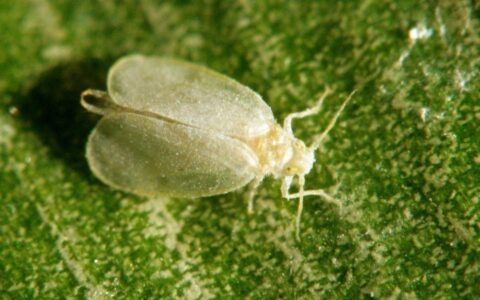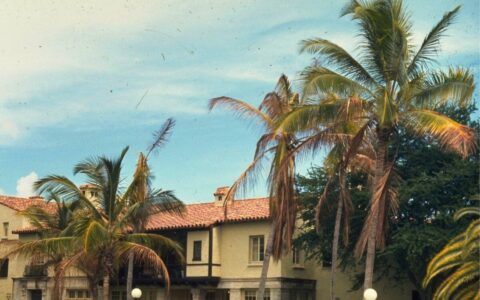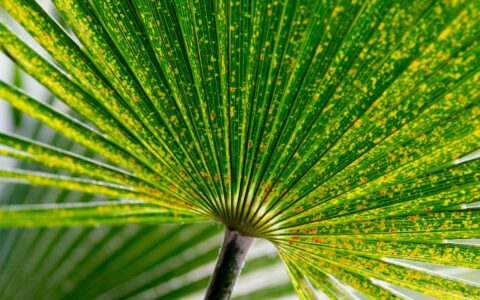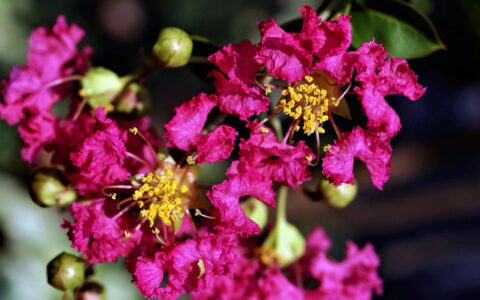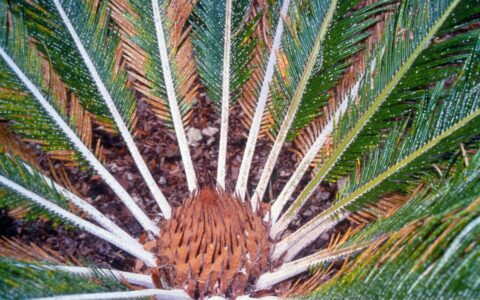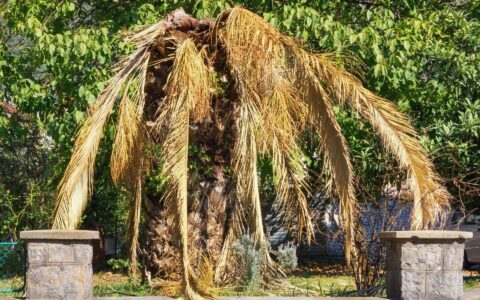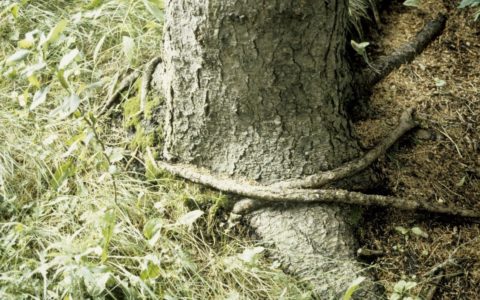Whiteflies are a common insect pest in South Florida that attack your trees, shrubs, and plants and are known to spread several viral diseases among Florida’s crops. Whiteflies are responsible for over $500 million in crop losses in Florida annually and are capable of extensive plant damage for homeowners – especially if they go untreated. So, what can you do about them?
Read on to learn more about controlling whiteflies, their damage to plants, and, most importantly, the biological, cultural, and chemical controls you can use in a plant health care program to keep whiteflies at bay.
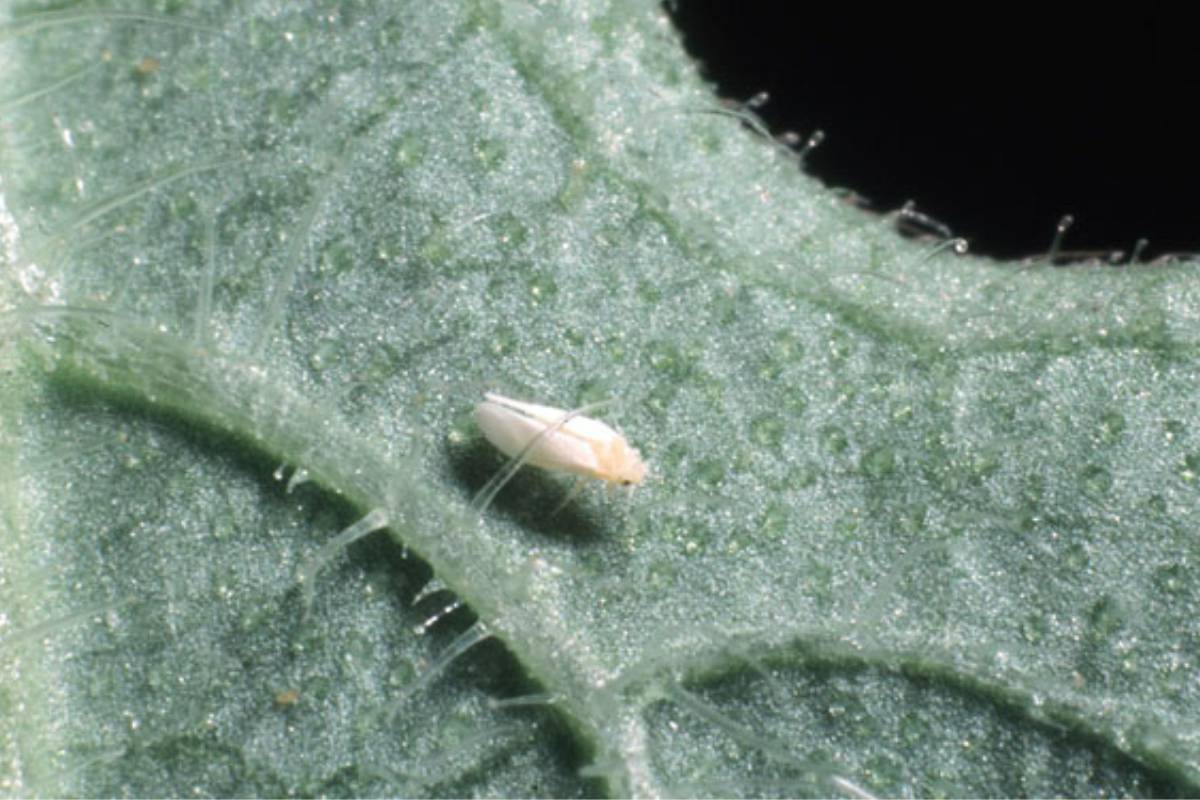
The silverleaf whitefly (also called sweet potato whitefly) is a prolific South Florida pest. Photo used courtesy of Alton N. Sparks, Jr., University of Georgia, Bugwood.org.
What are Whiteflies?
Whiteflies are a diverse group of insects of the Aleyrodidae family. While there are over 65 types of whiteflies in South Florida, some are worse than others, with some showing new resistance to pesticide controls. Whiteflies have presented such a significant problem in South Florida that Palm Beach County has even created a whitefly task force to battle the pest. The three whiteflies of most concern to South Florida residents are:
- Silverleaf whiteflies (also called the sweet potato whitefly)
- Citrus whiteflies
- Ficus whiteflies
Regardless of the species, a characteristic of whiteflies that makes them such prolific pests is their rapid reproduction. Each female whitefly can lay between 200-400 eggs during her lifetime. Since these eggs are laid directly on their food source – the underside of leaves – larval whiteflies can begin feeding immediately after hatching.
What Plants Attract Whiteflies?
Whiteflies are attracted to a variety of our South Florida plants, shrubs, and trees. Be on the lookout for whiteflies if you are growing any of the following:
- Ficus hedges
- Palm trees
- Citrus
- Tomatoes
- Cucumber
- Eggplant
- Peppers
- Sweet potatoes
- Cabbage
- Hibiscus
- Poinsettia
- Roses
- Petunias
What are the Signs of a Whitefly Infestation?
In addition to seeing the whiteflies themselves, infestations have several recognizable characteristics.
The leaves of infested plants will often turn pale green or yellow as the pests feed from the underside of the leaves. Sometimes these infections go undetected until the leaves begin to fall off.
Another indication of a potential whitefly infestation is an increased number of ants and flies on your plants. Like aphids, scale insects, and mealybugs, whiteflies secrete a sweet and sticky substance called honeydew that attracts these new insect pests.
This honeydew can also lead to the development of a fungus called sooty mold that coats stems and leaves. As the name suggests, sooty mold looks like a layer of black, powdery soot.
So, if you notice an influx of ants and flies on your plants and see signs of sooty mold, you could have a whitefly infestation.
How Can I Control Whiteflies?
While whiteflies are a prolific pest with a wide range of plant hosts, there are several methods you can employ to control their populations. These include:
- Biological Controls
- Cultural Controls
- Chemical Controls
Biological Whitefly Control
The most efficient biological control of whiteflies is several species of parasitic and predatory insects.
It’s important to note that these biological strategies shouldn’t be used in combination with a non-targeted chemical approach since pesticides often eliminate beneficial insects.
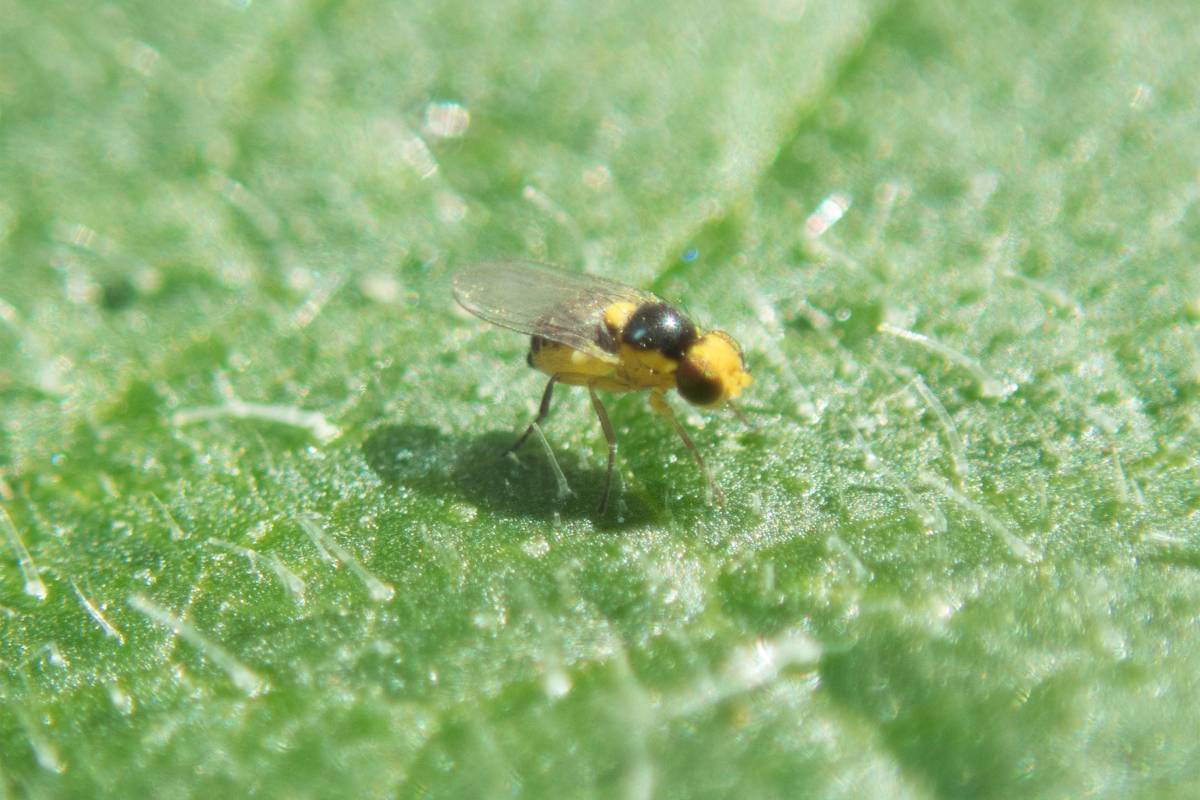
Wasps like this Encarsia Formosa can help naturally control whitefly populations by laying eggs in whitefly larvae, killing them before they can grow and damage your plants.
Parasitic Wasps
Encarsia formosa is a species of parasitic wasp that is effective against the greenhouse whitefly, while another wasp, Eretmocerus eremicus, is most effective against the silverleaf whitefly.
These wasp species attack larval (immature) whiteflies by laying their eggs inside the larva. These eggs develop, and upon hatching, the larval wasps eat the whitefly larvae from the inside out.
Predatory Beetles
Another biological control against whiteflies in South Florida is the ladybeetle, Delphastus catalinae. Though available commercially, this beetle is a Florida native and can consume a combination of 200 whitefly larvae and eggs per day.
Cultural Whitefly Control
Cultural control is the use of practices that reduce pest establishment, reproduction, and dispersal. These can include mechanical controls such as hand-picking pests from plants, physical controls such as netting to keep mosquitoes out of a structure, and environmental controls such as improved irrigation to deter water-loving pests.
[H4] Sticky Traps for Whitefly Control
Sticky boards or sticky traps are the most common method of trapping whiteflies. However, scientific tests have shown that this method isn’t always effective. Sticky boards can reduce whitefly population density indoors but aren’t very effective outdoors. Depending on the location of your infestation, these traps may or may not be helpful.
However, sticky boards are recommended for monitoring whitefly populations. Just be sure to use enough sticky traps – because whiteflies don’t fly far, many traps are necessary for accurate monitoring, especially in large areas.
Repellant Plants to Control Whiteflies
Several plants deter whiteflies with their scent. Consider incorporating these into your landscape if possible to repel whiteflies naturally:
- Dill
- Catnip
- Bee balm
- Basil
- Chives
[H4] Invite Whitefly Predators to Your Yard
Growing a diverse selection of plants in your landscape can help prevent and control whiteflies by naturally attracting beneficial predators. The whitefly has several natural predators, such as lacewings, big-eyed bugs, and minute pirate bugs, that will show up naturally with a mix of native plants.
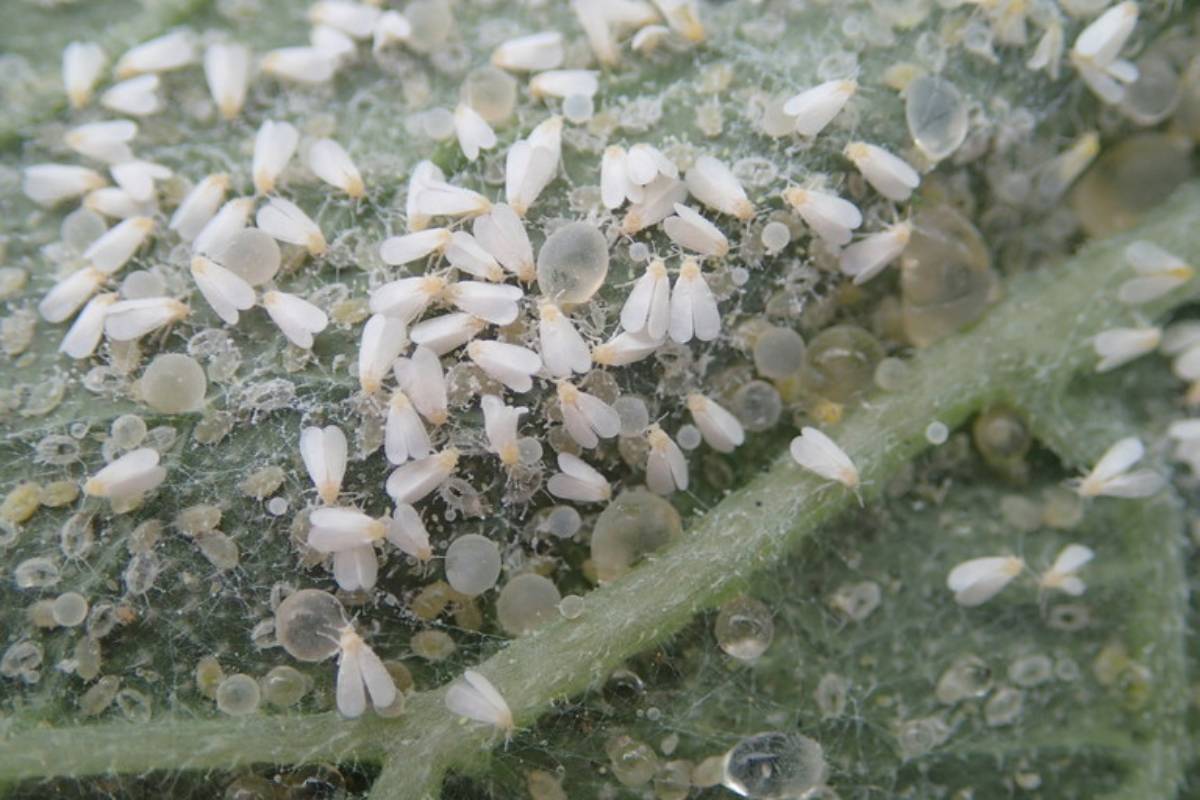
Greenhouse whiteflies are common pests in South Florida, where they rapidly infest a wide variety of plants. Photo courtesy of Whitney Cranshaw, Colorado State University, Bugwood.org.
Chemical Whitefly Control
Chemical control of whiteflies is typically reserved for extreme infestations that can’t be effectively controlled with biological or cultural methods. Among pesticides, there are organic and synthetic options that are available to consumers, as well as some that are best left to the professionals. For example, if whiteflies have infested a large ficus hedge, it’s best to call a tree care company with high-pressure equipment to effectively and efficiently spray the entire hedge.
Organic Pesticides
Organic pesticides used to knock down whiteflies include neem oil and other horticultural oil compounds that are sourced naturally. These foliar products are sprayed directly on plant leaves and work by clogging the whitefly’s spiracles (breathing holes in the abdomen), essentially suffocating them. Complete coverage of the plant (including the top and underside of leaves) is necessary for these products to be effective.
Another organic pesticide option includes products that contain the Beauveria bassiana fungus. This fungus attacks and kills whiteflies while leaving the host plants unharmed.
Though people generally consider organic pesticides “safe,” it’s essential to follow proper labeling instructions when applying organic pesticides. Organic pesticides kill both pests and beneficial insects, so use them cautiously.
Synthetic Pesticides
There are several synthetic pesticides shown to be effective against whiteflies. These treatments include contact pesticides that kill whiteflies when sprayed directly onto the pests. In contrast, systemic pesticides are taken up by plants into their tissues from the soil and then delivered to whitefly larvae as they feed.
While effective, these pesticides should be used cautiously, as overexposure can cause whiteflies to develop resistance. Often these treatments (such as the pesticide imidacloprid) will also kill beneficial insects, including honeybees and the insect predators that help fight whiteflies naturally. All pesticides should be used according to product labeling.
Do You Need Help Controlling Whiteflies?
Sherlock Tree Company can help with highly effective treatments for whiteflies or any other insect pest you may be dealing with in Broward, Palm Beach, and Miami-Dade counties. Our Tree Health Solutions team offers complete programs for insect pest control, tree and shrub disease treatments, and fertilization to ensure your trees stay healthy. Plus, our experts provide regular inspections of your trees and landscape to proactively identify any infestations or infections before they become a problem.
Call Sherlock Tree today at 954-570-0653 for more information, or use our online form to request a tree inspection from one of our arborists.
Call Sherlock for quality tree services
Whether you're looking for specific tree care services, such as palm trimming, tree removal, or disease treatments, or would like one of our Arborists to examine your trees to identify any issues and recommend options, we're always here for you! Just give us a call at 954-788-4000 to set up an appointment.
SEE MORE ARTICLES
Looking for more?
We've got you covered with a monthly newsletter full of tips, resources, updates, how-to's, and other helpful information about trees and landscapes in South Florida!

